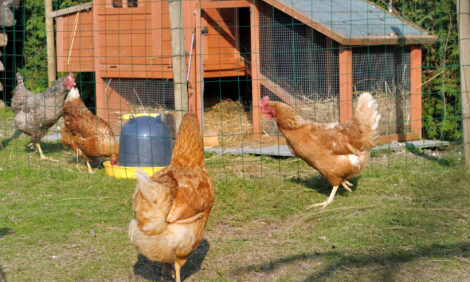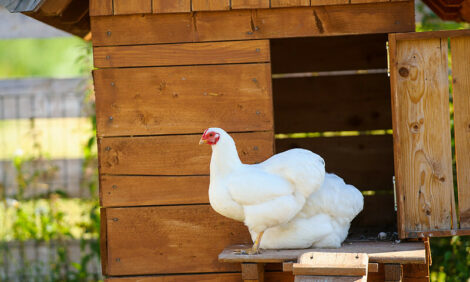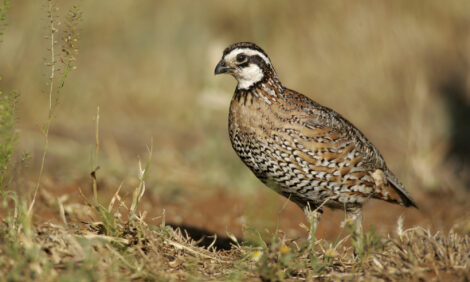



US Poultry Industry Manual - layer feed cost, intake and nutrition
Learn more about layer feed consumptionPart of Series:
< Previous Article in Series Next Article in Series >
Editor's Note: The following content is an excerpt from Poultry Industry Manual: The Foreign Animal Disease Preparedness and Response Plan (FAD PReP)/National Animal Health Emergency Management System (NAHEMS) Guidelines which is designed to provide a framework for dealing with an animal health emergency in the United States. Additional content from the manual will be provided as an article series.
3.3.1 Feed Cost and Consumption
Feed is the largest cost of egg production (approximately 60%). Each one million laying hens on a farm require approximately 120 tons of feed per day, 7 days per week. Ration formulas are tailored to meet the physiological needs of egg-type chickens and optimize their performance during each stage of growth and egg production.
3.3.2 Strain and Age Nutritional Requirements
Feed ingredient quality, strain of layer, and egg size requirements are used to develop a feeding program. Different genetic strains of egg-type chickens have different growth profiles and rations must be formulated to meet the requirements of each strain. Separate rations are formulated for pullets prior to the onset of sexual maturity (indicated by comb development) and for adult hens during the first egg production cycle, molting, and the second egg production cycle. First production cycle rations include pre-lay (3 weeks prior to 5% egg production); pre-peak (5% to 50% egg production); peak (50% egg production to 3 weeks post-peak); and post-peak. Second egg production cycle rations include prelay, peak, and post-peak. Phase feeding can be used to reduce the nutrient content of feed as egg production and associated nutritional needs decline. Laying hens are usually fed a mash feed.
3.3.3 Feed Intake, Egg Weight, and Body Weight
Feed intake determines nutrient intake and egg weights provide information about the adequacy of nutrient intake. Feed intake and egg weight are monitored throughout the laying period. Feed intake declines with inadequate space per bird, after beak trimming, during periods of heat stress, because of inadequate hours of light, following some vaccination procedures, and when consuming high energy rations. Adjusting the intake of protein, methionine or methionine plus cystine, and/or energy can be used to manage egg size. Feed formulations are adjusted as necessary to attain chicken body weight, body weight uniformity, egg production, and egg weight objectives.
3.3.4 Least Cost Feed Formulation
A professional nutritionist establishes feeding specifications, monitors performance, and revises the program as necessary for most egg production companies. Computer software utilizes data concerning nutrient requirements of the chickens at specific stages of their life cycle, nutrient content of available feed ingredients, price of available feed ingredients, ingredient restrictions, and nutrient restrictions to generate a ration formula which will meet nutritional needs at the least possible cost. Computers are used to formulate diets so that some strains of laying hens can produce a dozen eggs on less than 3 pounds of feed and require less than 2 pounds of feed to produce 1 pound of eggs.
3.3.5 Feed Mixing and Delivery
The mixing system and coordination of delivery are important to a successful feeding program. Feed is mixed in automated mills and delivered in covered hopper trucks to feed tanks at the egg farm. Ingredients are stored in separate bins, weighed with a computerized batch control system, and mixed under the direction of the batching system. Neither feed ingredients nor finished feeds are seen during the mixing process, so feed ingredients should be sampled at the mill before delivery and inspected at the farm upon delivery. Layer feed is not pelleted and tends to segregate, especially large particles of calcium, so a blend of several samples should be used for analysis. Saving samples from each feed delivery for 3 months is recommended.
Reference: "USDA APHIS | FAD Prep Industry Manuals". Aphis.Usda.Gov. 2013. https://www.aphis.usda.gov/aph...
The manual was produced by the Center for Food Security and Public Health, Iowa State University of Science and Technology, College of Veterinary Medicine, in collaboration with the USDA Animal and Plant Health Inspection Service through a cooperative agreement.















